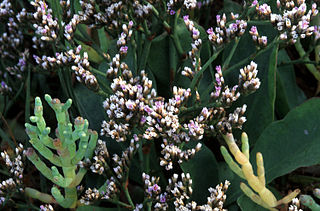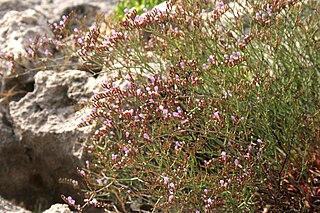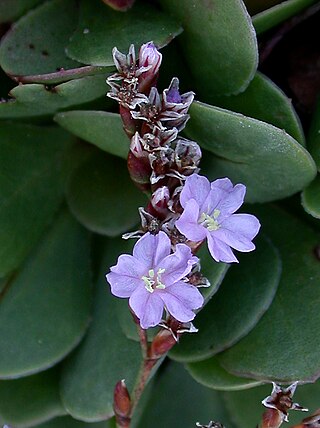
Limonium is a genus of about 600 flowering plant species. Members are also known as sea-lavender, statice, caspia or marsh-rosemary. Despite their common names, species are not related to the lavenders or to rosemary. They are instead in Plumbaginaceae, the plumbago or leadwort family. The generic name is from the Latin līmōnion, used by Pliny for a wild plant and is ultimately derived from the Ancient Greek leimon.

Limonium binervosum, commonly known as rock sea-lavender, is an aggregate species in the family Plumbaginaceae.

Limonium sinuatum, commonly known as wavyleaf sea lavender, statice, sea lavender, notch leaf marsh rosemary, sea pink, is a Mediterranean plant species in the family Plumbaginaceae known for its papery flowers that can be used in dried arrangements.

Limonium arboreum is a species of sea lavender known by the common name tree limonium and siempreviva. It is endemic to the Canary Islands, where it is a plant of coastal habitat.

Limonium californicum is a species of sea lavender in the family Plumbaginaceae. It is known by the common names western marsh rosemary and California sea lavender.

Limonium perezii is a species of Limonium known by the common names Perez's sea lavender and seafoam statice. It is also known as simply statice, sea lavender or marsh rosemary. It is native to the coasts of the Canary Islands but are widely used in gardens throughout the world.

Agdistis bennetii is a moth of the family Pterophoridae found in Europe. It inhabits salt marshes.

Limonium ramosissimum, the Algerian sea lavender, is a species of sea lavender (Limonium) native to the Mediterranean region. Its specific epithet rāmōsissimum means "many-branched" in Latin.

Limonium bellidifolium, commonly known as the matted sea-lavender, is an aggregate species in the family Plumbaginaceae.

Limonium narbonense is a species of sea lavender belonging to the family Plumbaginaceae.
The Kendall-Frost Mission Bay Marsh Reserve is a 20-acre University of California Natural Reserve System reserve on the northern shore of Mission Bay in San Diego County, California. Administered by UC San Diego, the site is owned by the University of California and managed for teaching and research.

Limonium vulgare, called common sea-lavender, is a species of flowering plant in the genus Limonium native to Atlantic parts of Europe from southwestern Sweden to southwestern Iberia and the Azores, and introduced elsewhere. A clumping perennial found in salt marshes and other maritime habitats, it is a probable species complex.

Limonium platyphyllum, the broad-leaved statice, or florist's sea lavender, is a species of flowering plant in the family Plumbaginaceae. It is native to the Black Sea region; Bulgaria, Romania, Ukraine, Crimea, south and east European Russia, and the Caucasus, and it has been introduced to Great Britain. A perennial halophyte 60 to 75 cm tall, it is widely available from commercial suppliers. There are a number of cultivars, including the well-known 'Violetta' which has darker petals.

Limonium puberulum, the downy sea lavender, is a species of flowering plant in the family Plumbaginaceae, native to subtropical elevations of Lanzarote in the Canary Islands. It is morphologically similar to but genetically distinct from Limonium bourgeaui.

Limonium bourgeaui is a species of flowering plant in the family Plumbaginaceae, native to Lanzarote and Fuerteventura in the Canary Islands. A herbaceous perennial and subshrub, it is morphologically similar to but genetically distinct from Limonium puberulum.
Limonium sinense is a species of flowering plant in the sea lavender genus Limonium, family Plumbaginaceae, native to coastal China, Taiwan, the Ryukyu Islands, and Vietnam. It is a perennial reaching 60 cm (24 in), found on sandy, salty shales next to the ocean. There are a large number of cultivars, with a wide variety of flower colors, created for the cut flower industry. Wild individuals have flowers with white sepals and yellow petals.
Limonium otolepis, the saltmarsh sea lavender, lacy sea lavender or Asian sea lavender, is a species of flowering plant in the family Plumbaginaceae. It is native to Afghanistan, Central Asia, and Xinjiang and western Gansu in China. A halophyte, it is common in saline areas, such as the bed of the former Aral Sea. It has been introduced to California as a garden escapee, and is also present in southeastern Australia. There appears to be an ornamental cultivar, 'Lavender Lace'.

Limonium bonduellei, the yellow statice, is a species of flowering plant in the family Plumbaginaceae. The Global Biodiversity Information Facility calls it Algerian statice and lists it as Limonium sinuatum subsp. bonduellei, but a 2018 molecular study showed that it is good species with 100% bootstrap support. An annual facultative halophyte reaching 50 cm (20 in), it is native to Spain and North Africa, and has been introduced to Italy. It is naturalized in New Zealand.

Limonium hyblaeum, the Sicilian sea lavender or Rottingdean sea-lavender, is a species of flowering plant in the family Plumbaginaceae, native to Sicily. A cushion-forming perennial, it is an incipient invasive in Australian coastal areas.
















